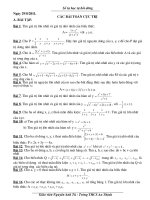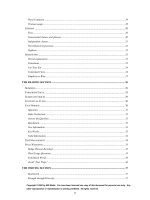Bí quyết trong các kì thi toeic 9 pptx
Bạn đang xem bản rút gọn của tài liệu. Xem và tải ngay bản đầy đủ của tài liệu tại đây (98.9 KB, 6 trang )
Look for the key words “since 1980” to be referenced in the correct answer
choice. Most valid answer choices would probably include a phrase such as
“since 1980, politicians have ”
Valid Information
Don’t discount any of the information provided in the passage, particularly shorter
ones. Every piece of information may be necessary to determine the correct
answer. None of the information in the passage is there to throw you off (while
the answer choices will certainly have information to throw you off). If two
seemingly unrelated topics are discussed, don’t ignore either. You can be
confident there is a relationship, or it wouldn’t be included in the passage, and
you are probably going to have to determine what is that relationship for the
answer.
Time Management
In technical passages, do not get lost on the technical terms. Skip them and
move on. You want a general understanding of what is going on, not a mastery
of the passage.
When you encounter material in the selection that seems difficult to understand,
it often may not be necessary and can be skipped. Only spend time trying to
understand it if it is going to be relevant for a question. Understand difficult
phrases only as a last resort.
Identify each question by type. Usually the wording of a question will tell you
whether you can find the answer by referring directly to the passage or by using
your reasoning powers. You alone know which question types you customarily
handle with ease and which give you trouble and will require more time.
34
Copyright © 2002 by MO Media. You have been licensed one copy of this document for personal use only. Any
other reproduction or redistribution is strictly prohibited. All rights reserved.
Final Warnings
Hedge Phrases Revisited
Once again, watch out for critical “hedge” phrases, such as likely, may, can, will
often, sometimes, etc, often, almost, mostly, usually, generally, rarely,
sometimes. Question writers insert these hedge phrases, to cover every
possibility. Often an answer will be wrong simply because it leaves no room for
exception.
Example: Animals live longer in cold places than animals in warm places.
This answer choice is wrong, because there are exceptions in which certain
warm climate animals live longer. This answer choice leaves no possibility of
exception. It states that every animal species in cold places live longer than
animal species in warm places. Correct answer choices will typically have a key
hedge word to leave room for exceptions.
Example: In severe cold, a polar bear cub is likely to survive longer than an adult
polar bear.
This answer choice is correct, because not only does the passage imply that
younger animals survive better in the cold, it also allows for exceptions to exist.
The use of the word “likely” leaves room for cases in which a polar bear cub
might not survive longer than the adult polar bear.
Word Usage Questions
When asked how a word is used in the passage, don’t use your existing
knowledge of the word. The question is being asked precisely because there is
some strange or unusual usage of the word in the passage. Go to the passage
and use contextual clues to determine the answer. Don’t simply use the popular
definition you already know.
35
Copyright © 2002 by MO Media. You have been licensed one copy of this document for personal use only. Any
other reproduction or redistribution is strictly prohibited. All rights reserved.
Switchback Words
Stay alert for “switchbacks”. These are the words and phrases frequently used to
alert you to shifts in thought. The most common switchback word is “but”.
Others include although, however, nevertheless, on the other hand, even though,
while, in spite of, despite, regardless of.
Avoid “Fact Traps”
Once you know which paragraph the answer will be in, focus on that paragraph.
However, don’t get distracted by a choice that is factually true about the
paragraph. Your search is for the answer that answers the question, which may
be about a tiny aspect in the paragraph. Stay focused and don’t fall for an
answer that describes the larger picture of the paragraph. Always go back to the
question and make sure you’re choosing an answer that actually answers the
question and is not just a true statement.
36
Copyright © 2002 by MO Media. You have been licensed one copy of this document for personal use only. Any
other reproduction or redistribution is strictly prohibited. All rights reserved.
The Writing Section
The Structure section of the TOEFL consists of a 30 minute section with one
essay topic.
A topic will be presented to you and you must write out approximately 300 word
discussion on it within the 30 minutes allowed. There is not a “correct” answer to
the topic. You must evaluate the topic, organize your ideas, and develop them
into a cohesive and coherent response.
You will be scored on how well you are able to utilize standard written English,
organize and explain your thoughts, and support those thoughts with reasons
and examples.
Brainstorm
Spend the first three to five minutes brainstorming out ideas. Write down any
ideas you might have on the topic. The purpose is to extract from the recesses
of your memory any relevant information. In this stage, anything goes down.
Write down any idea, regardless of how good it may initially seem. You can use
either the scratch paper provided or the word processor to quickly jot down your
thoughts and ideas. The word processor is highly recommended though,
particularly if you are a fast typist.
Strength through Diversity
The best papers will contain diversity of examples and reasoning. As you
brainstorm consider different perspectives. Not only are there two sides to every
issue, but there are also countless perspectives that can be considered. On any
issue, different groups are impacted, with many reaching the same conclusion or
position, but through vastly different paths. Try to “see” the issue through as
many different eyes as you can. Look at it from every angle and from every
37
Copyright © 2002 by MO Media. You have been licensed one copy of this document for personal use only. Any
other reproduction or redistribution is strictly prohibited. All rights reserved.
vantage point. The more diverse the reasoning used, the more balanced the
paper will become and the better the score.
Example:
The issue of free trade is not just two sided. It impacts politicians, domestic (US)
manufacturers, foreign manufacturers, the US economy, the world economy,
strategic alliances, retailers, wholesalers, consumers, unions, workers, and the
exchange of more than just goods, but also of ideas, beliefs, and cultures. The
more of these angles that you can approach the issue from, the more solid your
reasoning and the stronger your position.
Furthermore, don’t just use information as to how the issue impacts other people.
Draw liberally from your own experience and your own observations. Explain a
personal experience that you have had and your own emotions from that
moment. Anything that you’ve seen in your community or observed in society
can be expanded upon to further round out your position on the issue.
Pick a Main Idea
Once you have finished with your creative flow, stop and review it. Which idea
were you able to come up with the most supporting information? It’s extremely
important that you pick an angle that will allow you to have a thorough and
comprehensive coverage of the topic. This is not about your personal
convictions, but about writing a concise rational discussion of an idea.
Weed the Garden
Every garden of ideas gets weeds in it. The ideas that you brainstormed over
are going to be random pieces of information of mixed value. Go through it
methodically and pick out the ones that are the best. The best ideas are strong
points that it will be easy to write a few sentences or a paragraph about.
Create a Logical Flow
Now that you know which ideas you are going to use and focus upon, organize
them. Put your writing points in a logical order. You have your main ideas that
38
Copyright © 2002 by MO Media. You have been licensed one copy of this document for personal use only. Any
other reproduction or redistribution is strictly prohibited. All rights reserved.
you will focus on, and must align them in a sequence that will flow in a smooth,
sensible path from point to point, so that the reader will go smoothly from one
idea to the next in a logical path. Readers must have a sense of continuity as
they read your paper. You don’t want to have a paper that rambles back and
forth.
Start Your Engines
You have a logical flow of main ideas with which to start writing. Begin
expanding on the issues in the sequence that you have set for yourself. Pace
yourself. Don’t spend too much time on any one of the ideas that you are
expanding upon. You want to have time for all of them. Make sure you watch
your time. If you have twenty minutes left to write out your ideas and you have
ten ideas, then you can only use two minutes per idea. It can be a daunting task
to cram a lot of information down in words in a short amount of time, but if you
pace yourself, you can get through it all. If you find that you are falling behind,
speed up. Move through each idea more quickly, spending less time to expand
upon the idea in order to catch back up.
Once you finish expanding on each idea, go back to your brainstorming session
up above, where you typed out your ideas. Go ahead and delete the ideas as
you write about them. This will let you see what you need to write about next,
and also allow you to pace yourself and see what you have left to cover.
First Paragraph
Your first paragraph should have several easily identifiable features.
First, it should have a quick description or paraphrasing of the topic. Use your
own words to briefly explain what the topic is about.
Second, you should explain your opinion of the topic and give an explanation of
why you feel that way. What is your decision or conclusion on the topic?
Third, you should list your “writing points”. What are the main ideas that you
came up with earlier? This is your opportunity to outline the rest of your paper.
Have a sentence explaining each idea that you will go intend further depth in
39
Copyright © 2002 by MO Media. You have been licensed one copy of this document for personal use only. Any
other reproduction or redistribution is strictly prohibited. All rights reserved.









